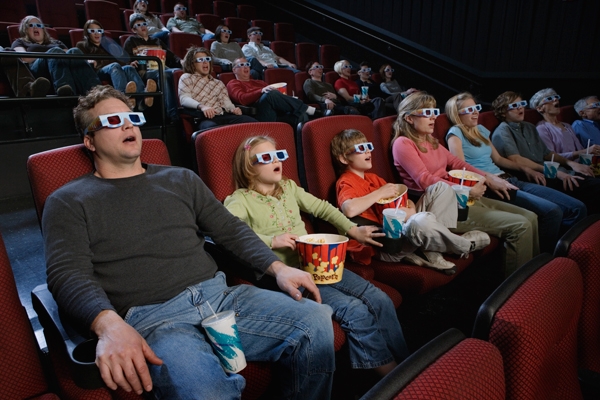(Photo: Fuse)
If there is one thing I don’t do enough, it’s going to the movie theaters. Time and responsibilities can do that, but when a huge movie is about to premiere, I do what I can to make the trip out. So with Star Wars the Force Awakens now available (and smashing records), I’ve wondered if I should decide to watch it in the “ever popular” format of 3-D. After all, 3-D movies are all the rage with viewers now, at least, that’s what Hollywood has pushed. Oh wait, they aren’t. In fact, one could argue that 3-D movies are the reason many consumers do not travel to theaters and wait till it’s available to stream at home. So even with the incredible success, that Star Wars Episode Seven has had, will this make 3-D movies more popular with casual viewers? Or will it be a special case meaning that producing 3-D movies is a waste of time?
The apparent reason as to why audiences do not care about 3-D movies is mostly due to the cost of admission to view a 3-D film. Ticket prices are already high due to inflation and companies want to make a profit from the film. 3-D tickets are much more expensive than their regular counterparts, so apparently directors and producers look at 3-D films as a way to help mitigate any loss of revenue.
But the price tag on 3-D tickets can scare customers away indefinitely. I’d be worried if movie theaters only showed films in 3-D. I’m sure many readers can recall having a couple of dollars on them, and go to an afternoon screening. It was a cheap and fun way to spend time with friends. However, now with the price of admission going up, many feel it’s better just to stay at home.
So due to low attendance numbers, 3-D films were added as an option for theaters to try and draw in fans away from streaming movies at home. Many thought that 3-D films would be able to entice fans to have a movie night at the theater instead of home. However, they have had the opposite effect on the market. While many would understand the price hike due to the process it takes to make a 3-D film, it’s for some reason pushing potential consumers away. Many directors felt that streaming movies a few months after a movie premieres would cause some issues with overall capital, but fans were fine with going out for a movie night. It’s just that with how much 3-D is pushed (by advertisements), it gets annoying. So adding this option has done the opposite of what filmmakers wanted.
What makes this even sillier for Hollywood is that making 3-D movies was their response to services that stream movies in the comfort of viewers’ home. Sadly what Hollywood might of missed was that, if they wanted more people to go out to the theater, maybe they should have asked consumers what they would want instead of assuming that 3-D films would become the next big thing. It can be a distraction to the overall picture. Because right now it looks as if fans do not care if a movie is in 3-D or not (saying they are content on classic films).
Do you like to see movies in 3D or just regular (2D)?
— Geek E Inc. Productions (@GeekEInc) December 24, 2015
Is there a large contingency that enjoy “feeling a part” of the movie? The last 3-D film I saw was Angelina Jolie’s Beowulf (for a school field trip after reading the story). To be honest, while it did feel like I was in the movie itself, I felt dizzier by watching the film so that I couldn’t enjoy it. So if I had issues with it (dizziness), I’m sure there are others just like me who feel dizzy as well.
So why are there more and more films shown in iMax and 3-D theaters? The reason I ask this is because a lot of the films in 3-D aren’t specially made for those types of projectors. So instead of feeling like you are fully in this world, you get weird special effects that look dizzying. Not to mention, but projectors that show the film at the theaters, aren’t always made for 3-D films. So with the recent phenomena of Star Wars hitting theaters everywhere, some might have a miserable experience because of the lens used. For a 3-D movie to work and be well-received, is has to be made for it. A perfect example is the film Avatar. What made this film work so well in theaters was because director James Cameron diligently made the movie with that intention. He wanted viewers to feel like they were on the Avatar planet, and it certainly didn’t disappoint when you look at the graphics.
So what happens when one movie in 3-D breaks a ton of records? Every film company and director wants to try and match what was successful. So instead of film companies taking their time to make sure things will work, they assume they can rush the process at half the cost. Thus, fans get a mess at the theaters, forcing them to go strictly to regular showcases. It falls under the theory that high definition just makes everything on a screen look better. That’s not necessarily the case, especially when you look at television news broadcast. If someone looks bad on standard definition, they will look worse in high definition. The same applies to film. If it were made to be viewed in 3-D, it would look fantastic. The process is long and painstaking, but rewarding. But if it’s rushed and only meant for standard definition, then it shouldn’t be shown in 3-D, period.
Of course, the phenomena of 3-D hasn’t exactly taken off like many thought it would. Forbes’ contributor John Archer, wrote an interesting piece about the fleeting popularity of 3-D films back in 2014. Archer brought up on how the total number of available 3-D movies dropped, and how that trend will probably continue. Adding to that, Archer also stated about how 3-D movies only attributed to 39 percent of revenue for films (in 2014), compared to 53 percent back in 2012. So interest has been steadily dropping for a while, making me wonder why this is still a “popular option” for audiences. On the flip side, there was talk about having 3-D television sets in
On the flip side, there was talk about having 3-D television sets in homes, but that also hasn’t exactly been purchased by many people. I have a feeling that due to poor showings in theaters, many have avoided 3-D systems. Plus I’m sure those glasses can be annoying for some to deal with, especially for someone who wears glasses all the time.
I have a feeling that Star Wars: The Force Awakens works fine in 3-D. Thus, bringing up the question if 3-D movies are going to start performing better in the movie industry. After all, Hollywood needs to do whatever they can to keep profits up for the future. However, fans seem to think that other aspects should be worked on instead of the presentation (like actually make a solid film). 3-D won’t make a bad movie better, and directors and writers should look into making the overall product better. With the technology and minds at Hollywood’s disposal, bad movies shouldn’t be as numerous as they are. Special effect tricks won’t fool the public into thinking something was better than it is. But it looks like 3-D movies will be here to stay, due to successes like Avatar and Star Wars. I just hope that movie theaters are ready for more people not to show up.
C.J Maffris is a contributor for Geek-E Inc.com. He feels that the fad of 3-D movies should end sooner rather than later. Feel free to follow C.J on Twitter @SeaJayMaffris

